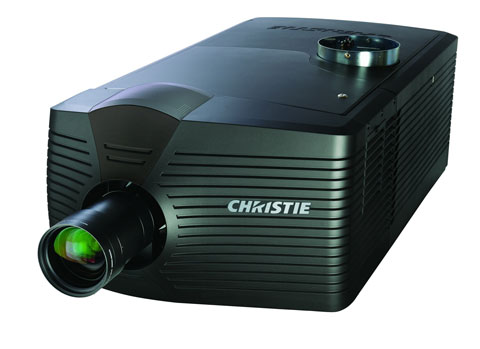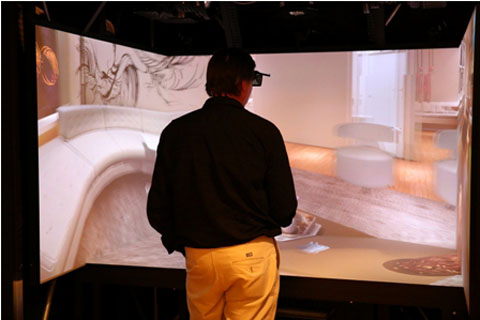
The zSpace holographic display system showcased applications from companies such as TechViz, CEI (EnSight), Siemens PLM (Teamcenter) and Lumisaphe
Immersive 3D displays, once outliers on the SIGGRAPH show floor for product-development applications, appear to be increasingly swimming in the mainstream.
Last year, I tried to quantify the potential impact of the zSpace holographic display system on design and engineering professionals: “It means being able to delve inside designs at a level only imagined a few years ago.
It means being able to collaborate with greater depth and intuitive understanding – a feeling – that hasn’t existed up until now. And, as with all great technology, it means we are only sniffing at the potential – the applications will proliferate like rabbits in spring once people experience this stuff.”
The news this year is that the potential is being fulfilled. According to Dave Chavez, zSpace’s chief technology officer, 400 developers recently attended a conference to explore bringing their applications to zSpace.
In booth #116 on the SIGGRAPH show floor, Chavez and his colleagues were showcasing applications from companies such as TechViz, CEI (EnSight), Siemens PLM (Teamcenter) and Lumisaphe – all running seamlessly in the zSpace environment.
One of the zSpace demos showed a realistic beating heart behind a set of lungs. Use the stylus to click on the surface of the heart, select the new transparency functionality and the inner workings are revealed in rich detail. It’s easy to see the type of insights this could provide for visualizing computational fluid dynamics (CFD) inside valves, cavities and pipes. Or to simulate the workings of machinery that are invisible to the naked eye.
At a price of $4,000, the zSpace provides one of the most accessible, engaging examples of 3D immersion. It’s not difficult to imagine this device leading to a range of applications similar to those ushered in by 3D scanning over the past several years.
The über-real and not-so-real
Christie is demoing two immersive displays in booth #159 on the SIGGRAPH show floor: The Christie Mirage 4K25 DLP 3D projector and the newly kitted-out Christie HoloStation.
The Mirage 4K25 boasts 1.2 gigapixel-per-second processing and 4,096 x 2,160 resolution at 120Hz for 2D and 3D. Rave Computer’s Render Cube is being used to drive content on the Mirage 4K25 at the show.
At SIGGRAPH, the model Audi car displayed by the Mirage 4K25 shows no trace of pixelization even when zooming in for a close up.
The high-dynamic range imaging (HDRI) and up to 25,000 lumens of brightness showed every detail of the reflected background buildings and lighting, sorely tempting one to reach out and touch the car’s silver surface.

Christie’s Mirage 4K25 DLP 3D projector boasts 1.2 gigapixel-per-second processing and 4,096 x 2,160 resolution at 120Hz

The Christie HoloStation is a personalized CAVE, with a 85-inch by 108-inch by 101-inch footprint
Compared to the Mirage 4K25, the HoloStation is somewhat of a disappointment. Christie considers it a personalized CAVE, with a 85-inch by 108-inch by 101-inch footprint. The latest version is a more refined product than last year’s prototype, with extended screen space on the sides, doors that close for privacy, and neater hiding of the wiring on the ceiling.
But, like most CAVEs, the images appear a bit washed out, like a slightly faded watercolour. There’s also not enough screen height: When a tall person (I’m about 6’ 3”) stands in front of it, the display is cut off just above the top of the head, undermining the full illusion of reality.
Can you say dodecagon?
The final stop of my immersive tour was Vicon, booth #711 on the show floor.
Vicon has been in the VR game for 25 years, continually working to increase realism while decreasing prices. The company’s systems are being used by companies such as General Motors, Ford and Disney Imagineering. According to Warren Lester, Vicon’s manager of engineering products, the UK’s Atomic Weapons Establishment has used Vicon systems to save more than £1million in physical prototypes.
Vicon is showing its Apex dodecagon (12-sided) 3D input device, which the company says enables more stable tracking in a product-development environment. See a video demo of Apex below.
//www.youtube.com/embed/v6Y41fz0bWk?list=UUMJ8Y90iMhuBUlTb09LhAFw
From bytes to bites
Following multiple immersions in full 3D, it was almost a disappointment to slip on my pedestrian eyeglasses (near-sighted) and once again tread in the real world. The colours and details seemed muted and I couldn’t peer inside of solid objects. But, the rug on the show floor felt comforting and the familiar movements of real people eventually brought me back to reality.
Besides, it was lunch time and I was hungry, a craving I couldn’t satisfy in the virtual world.
Tomorrow: Real-life adventures in 3D rendering. Yes, it just keeps getting better.
The author of this post, Bob Cramblitt, writes about design, engineering and manufacturing technologies that change the way products are developed, tested and marketed. He can be reached at info@cramco.com






